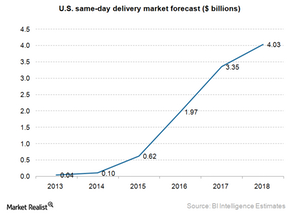Why Same-Day Delivery Is Imperative in E-Commerce
The US same-day delivery market could grow from $0.10 billion in 2014 to $4.03 billion in 2018 at a CAGR (compound annual growth rate) of 150%.
June 5 2015, Published 2:52 p.m. ET

Amazon is taking its same-day delivery service to the next level
According to a news piece from the Wall Street Journal, Amazon (AMZN) won’t charge an extra fee of $5.99 for same-day delivery service to its prime members. The idea is to kill two birds with one stone with this new offer.
Amazon Prime is a membership program that costs $99 per year. By using this program, Amazon’s customers get free shipping on the goods they order from Amazon. The free same-day delivery service will help counter the challenge Amazon faces from upcoming startups who operate with a local team of workers and brick-and-mortar retailers who have an additional advantage, which is instant delivery.
Amazon hopes that this new offer would also prompt customers to buy Amazon’s prime membership and then stay with Amazon for longer once enrolled. Thus, Amazon would benefit in two different ways with this offer.
According to a report from Business Insider’s BI Intelligence research service, and as the above chart shows, the US same-day delivery market could grow from $0.10 billion in 2014 to $4.03 billion in 2018 at a CAGR (compound annual growth rate) of 150%.
Logistics define the future of e-commerce players
In today’s world of online retail, logistics play a key role in defining the future of e-commerce players. Amazon, like its competitors, is working towards building a strong logistics network and up its game by making delivery of goods as convenient and fast as possible for its valued customers.
eBay (EBAY) has partnered with Argos stores in the United Kingdom. Through this partnership, goods sold by eBay’s merchants online will be available for customers to pick up immediately at Argos stores. Similarly, Google (GOOG) offered the Google Express service. It’s a same-day shopping service for orders that consumers place online from retail stores like Staples (SPLS) and Walgreens.
You can get exposure to Amazon by investing in the Consumer Discretionary Select Sector SPDR Fund (XLY). It has a 6.1% exposure to Amazon.
